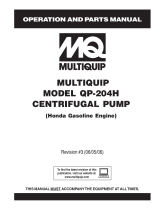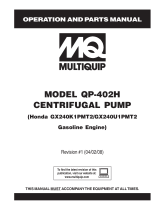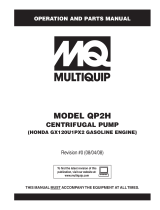
Gasoline Chemical Pump
Owner’s Manual
DuroMax Customer Service
customer_service@duromaxpowerequipment.com
800-629-3325 Monday - Friday 7am to 5pm. PST


This manual provides information regarding the operation and maintenance of these products. We have
made every effort to ensure the accuracy of the information in this manual. We reserve the right to
change this product at any time without prior notice.
Please keep this manual available to all users during the entire life of the gasoline water pump.
CONTENTS
1.
General Safeguards ................................................. 4
2. Location of Component Parts ................................... 6
3. Operation before Starting Up .................................... 7
4. Starting of Engine ..................................................... 12
5. Use in High Altitude .................................................. 14
6. Operation of Water Pump .......................................... 15
7. Shutting Down the Engine ......................................... 16
8. Maintenance ............................................................. 17
9. Transportation and Storage ...................................... 22
10.
Troubleshooting ........................................................ 24
11.
Specifications ............................................................. 25
3
12.
Parts Diagrams .......................................................... 27
13.
Warranty .................................................................... 33

Ⅰ. General Safeguards
Safety Precautions
Before starting the engine, perform inspections according to
the procedures described on pre-operation inspections
to avoid accidents and damage to your machine.
For safety, never attempt using this GEP (gasoline
engine powered) water pump to deliver inflammable or
corrosive liquids (such as gasoline and acids). Likewise,
corrosive mediums, seawater, chemical solvents, alkaline
liquids (such as used gasoline, liquor and honey) should be
avoided.
Place the water pump on a solid, level position surface to
avoid tilting or turnover that may give rise to spilling of fuel.
To prevent fire hazards, keep the pump well ventilated
during operation and maintain a distance of at least l meter
between the machine and the wall or other machines.
Keep away from inflammable substances.
Do not allow children and pets to enter the working area as
this may increase the chance of their getting burned by hot
surfaces of the operating parts.
Know how to stop the water pump quickly how to operate
the controls. Do not use the pump against the prescribed
operating rules.
Please read this operation manual to have a
thorough understanding of the content there
before use the product. Failure to do so may
lead to personal injury or mechanical damage.
4

WARNING: Safety Precautions
The gasoline fuel is highly inflammable and may explode
under certain conditions.
Fuel with the engine shut down and in a well-ventilated
environment. No smoking is allowed and no open fire or sparks
allowed to exist in areas where fueling is carried out or the fuel is
stored.
Do not allow the fuel to overflow the fuel tank. Be sure to
recap the tank and tighten it after refueling.
When fueling, take care not to spill the gasoline about as the
gasoline vapor may easily get ignited to cause a fire hazard. Be
sure to remove the spilled gasoline as by wiping before starting
the engine.
Do not run the engine indoors or in a poorly ventilated space
as the exhaust gas produced by the running engine contains toxic
carbon monoxide that may cause the loss of personal
consciousness or even death.
5

Ⅱ. Location of Component Parts
Discharge
Frame
Fuel Cap
Muffler
Air Cleaner
Controls
Recoil Start
Engine Switch
Oil Fill
Fill Cap
Discharge
Suction
Drain Cap
Oil Drain Bolt
Low Oil
Sensor
6

Ⅲ. Operation before Starting Up
1. Connecting the water inlet
Connect the water inlet with a commercially available
hose, connector and fastener clip. The inlet hose must be a
continuous non-foldable structure with a length not more than
required and should be placed near to the source of water so as
to achieve the pump should be fitted to the end of the hose with
the hose connector as shown in the figure below.
CAUTION: Before pumping water, attach the filter to the end of
the hose to filter out foreign matters in the water, the presence
of which may cause clogging and damage to the wane wheel.
NOTE: The hose connector and fastener clip should be securely
fastened to prevent air leaks and reduction in suction power. A
loose hose will reduce the pump performance and self-suction
capacity.
2. Connecting the water outlet
Connect the water outlet with a commercially available hose,
hose connector and fastener clip. Large diameter hoses are the
most effective while small ones will increase the flow resistance
and reduce the output power of the pump.
7

NOTE:
Be sure to the fastener clip is securely fastened to prevent
the outlet hose from coming off under high water pressure.
3.Checking the oil level
CAUTION:
•
The oil is one of the major factors affecting engine
performance and life. Do not use dirty oil or vegetable oil.
•
Be sure to check the oil level with the engine shut down and
placed on a level surface.
•
Please use the SE15-40, 4-stroke engine oil as
recommended.
•
Please use the type of oil with a proper viscosity according
to the local average temperature.
•
Oil shortage alarm system (OSAS) (installation position)
The OSAS is designed to avoid damage of the engine due
to the shortage of oil in the crankcase. The system will
automatically shut down the engine just before the
crankcase oil level drops down to the minimum line of
safety (with the engine switch staying in the ON position).
•
If the engine is shut down and cannot be started again,
check the oil level before initiating further troubleshooting
procedures. Remove the oil dipstick and wipe it dry.
Insert the dipstick into the oil filler but not screw it in.
Replenish the crankcase with the recommended type of oil
until the oil level comes up to the upper most position of the
refilled if the existing oil level is found too low.
8

CAUTION:
·Running the engine at a low oil level will cause damage to it.
4. Checking the fuel level
Uncap the fuel tank and check the fuel level. Pouring gasoline if
the fuel level is found too low.
Please use the type of gasoline recommended by the Dealer.
Do
not use a mixture of gasoline and oil or dirty gasoline to prevent
dirt, dust or water from entering the fuel tank.
CAUTION:
• The gasoline fuel is highly inflammable and may explode
undercertain conditions.
• Do the fueling with the engine shut down and in a well-
ventilated environment. No smoking is allowed and no open
fire or sparks allowed to exist in areas where fueling is carried
out or the fuel is stored.
• Do not allow the fuel to overflow the fuel tank. Be sure to recap
the tank and tighten it after refueling.
9

·When fueling, take care not to spill the gasoline about as
the gasoline vapor may easily get ignited to cause a fire
hazard.
·Be sure to remove the spilled gasoline as by wiping before
starting the engine.
·Avoid frequent or extensive exposure of the skin to gasoline or
breathing in the gasoline vapor. Keep the gasoline out of the
reach of children.
·Fuel tank capacity: 1.0 gallons (US. 3.6 liters)
5. Checking the air cleaner
filter element
Screw the wing nut and remove
the washer and cleaner cover.
Check the filter element to see if
it is too dirty and clean it if
necessary.
CAUTION:
Do not run the engine without the
air cleaner as this may quicken
engine wear if dirt or dust is
sucked into the engine through the
carburetor.
10

6. Checking and filling the pump with cooling water
The pump must be filled with water before it is put to
operation. CAUTION:
·Do not attempt running the pump without cooling water
or the pump will get overheated. Extensive running without
cooling water may also damage the air tightness of the
pump. If the pump is found running dry, stop the engine
and pouring in water when it cools down.
11

Ⅳ. Starting engine
1. Turn on the fuel tap (by setting it to the ON position).
2. Close the choke.
NOTE:
·The choke is not required when starting the engine warm or
the ambient temperature is rather high, (i.e. keep the choke
open when starting the engine).
3. Set the engine switch to the ON position.
4. Turn the throttle control lever slowly to the left.
12

5. Gently pull up the starter lever until a resistance is felt and
then
quickly pull it up.
CAUTION:
·Do not allow the starter lever to retract quickly into the engine.
Let it go back gently to avoid damaging the starter.
Ⅴ.Use in High Altitude
Operation in High Altitude
In highland areas (with a high ASL elevation), the air-fuel
mixture produced by a standard carburetor will be too thick
and result in a reduced engine performance and soared fuel
consumption. For operation in highland areas, the engine
performance may be increased by using a smaller
diameter carburetor nozzle and readjusting the carburetor idle
speed. If the water pump is frequently used in areas with a ASL
elevation of more than 1800 meters (6000 feet), ask the local
dealer to replace or readjust the carburetor beforehand.
Even if the engine is fitted with a carburetor nozzle of an
appropriate size, the engine power will still go down by about
3.5% each time when the ASL elevation goes up by 305
meters (1000 feet). If no replacement or readjustment is
ever made of the carburetor, the highland effect of the
engine output power will be even more obvious.
13

·Using the water pump in areas where the ASL elevation is
lower than suitable for the carburetor nozzle will lead to a
decreased engine performance and overheating of the engine
and even cause serious damage to the engine due to an
extremely thin air-fuel mixture.
Ⅵ. Operation of the Water Pump
1. Gradually open the choke after the engine warms up.
2. Set the throttle to the predetermined RPM.
CAUTION:
14

Ⅷ. Maintenance
Periodic inspections and fine-tuning are simply
indispensable to keep the water pump working with high
performance and regular maintenance may also lengthen the
pump life. Supplied in the table on the next page are intervals
at which the schedules maintenance jobs are to be done.
WARNING:
·Before any maintenance attempt, be sure to shut down
the engine. If the maintenance job has to be done with the
engine at work, it should take place in a well-ventilated
space as the exhaust gas contains toxic carbon monoxide
that causes the loss of personal consciousness or even
death.
Ⅶ. Shutting Down the Engine
1. Set the throttle control lever to the right end.
2. Set the engine switch to the OFF position.
3. Turn off the fuel tap (by setting to the OFF position).
NOTE:
·To shut down the engine in an emergency, simply set the
engine switch to the OFF position.
15

CAUTION:
·In cases when the pump is used to suck up seawater, be sure
to flush it with fresh water immediately after use to minimize
corrosion and remove deposits.
·Always use the original parts and relevant tools supplied with
the machine to carry out maintenance. Failure to do this may
cause damage to the pump.
NOTE:
⑴ Inspection and maintenance should take place more
frequently if the pump is used in a dirty environment.
Table of Maintenance Schedules
Normal
maintenance
Item period
Each
time
Per
month
or 20
hours
Per
month
or 50
hours
Per
month
or 100
hours
Per
month
or 300
hours
Check engine oil
level
○
Replace engine oil
○ ○
Air cleaner check
○
Air cleaner for clean
Spark plug
○ ○*
Fuel supply Replace per every two years
Impeller
○*
Pump case cover
○*
Water inlet
○*
16

1. Replacing the engine oil
Oil drains easily and quickly while the engine is warm.
1. Remove the oil dipstick and drain bolt to let out the oil.
2. Screw the drain bolt back in place and tighten it.
3. Pour in clean oil until the desired level is reached.
Oil capacity: 0.6 liters (20 oz)
Clean your hands with soap if stained with the engine oil. NOTE:
Be sure to keep the environment clean when disposing used
engine oil. We suggest you collect the waste oil in a container to
be sent to a waste disposal site or a recycling service center of
spill it in the garbage or on the ground.
2. Maintaining the air cleaner
A dirty air cleaner will let less air into the carburetor. To
prevent carburetor malfunctions, be sure to maintain the air
cleaner periodically. More frequent maintenance of the air
cleaner will be necessary if the pump is working in an extremely
dirty environment.
DO not clean the air cleaner with a low ignition point solvent
because catch fire or even explode under certain circumstances.
17

CAUTION: Do not use the water pump without an air cleaner.
The dirt or dust if sucked into the engine may quicken engine
wear.
1) Unscrew the wing nut and remove the air cleaner cover
and filter element.
2) Clean the filter element with a detergent solution
inflammable or with a high ignition point and let it dry thoroughly
after cleaning.
3) Immerse the filter element into clean oil and then squeeze
out the excessive amount of oil.
4) Put the filter element as well as the air cleaner back in place.
3. Maintaining the spark plug
The recommended type of spark plug is NHSP LD P6RTCU.
To ensure normal operation of the engine, the spark plug
should have a correct gap and should remain free of carbon
deposits.
1) Remove the plug cap.
*The muffler may be very hot if the engine is still running. Take
care not to touch the muffler.
2) Check the spark plug visually. Discard the spark plug if it is
18

obviously worn out or the insulation ring on it is broken or
cracked. Clean the spark plug with a brush when put it back in
place.
3) Check the plug gap with a feeler gauge. Vary the gap by
moving the side electrode. Normal plug gap: 0.70~0.80mm
4) Check the plug O-ring for normal condition. Screw it in with
the plug wrench to protect the plug thread.
NOTE:
·In the case of screwing in a new spark plug, tighten it by
an additional 1/2 screw turn after the plug reaches and pushes
on the O-ring, while in the case of a used spark plug, an
additional 1/2~1/4 screw turn is necessary.
CAUTION:
· Make sure the spark plug is properly tightened.
Improper tightening may cause the engine to be overheated
or damaged. Never use spark plugs with an incorrect thermal
value range.
19

Ⅸ. Transportation and Storage
CAUTION:
·To avoid causing a fire hazard, let the engine cool down
before transportation or indoor storage of the pump.
··Before transporting the pump, set the fuel tap to the OFF
position and place the pump body in a level position to prevent
the fuel from spilling out. The spilled gasoline or the gasoline
vapor may get ignited.
·Note and do the following before storing pump for an extended
period of time:make sure the storage area is free of moisture
or dust.
·Clean the inside of the pump. The pump may get clogged if it
is used to suck up water containing such matter as earth, sand
or heavy fragments.
·Before storing, clean the pump by sucking up clean water or
otherwise the impeller may be damaged when the pump is put
to use again. After cleaning, unscrew the water drain plug to
drain off the water from inside the pump casing as much as
possible. Then screw the drain plug back into place.
3) Drain off the fuel.
a. Turn off the fuel tap (OFF position), unscrew the drain
screw from the carburetor float chamber to drain off the fuel
from inside the carburetor and collect the gasoline in a suitable
container.
b. Turn on the fuel tap (ON position) and collect the gasoline in
a suitable container.
20
Page is loading ...
Page is loading ...
Page is loading ...
Page is loading ...
Page is loading ...
Page is loading ...
Page is loading ...
Page is loading ...
Page is loading ...
Page is loading ...
Page is loading ...
Page is loading ...
Page is loading ...
Page is loading ...
Page is loading ...
Page is loading ...
Page is loading ...
Page is loading ...
/
















